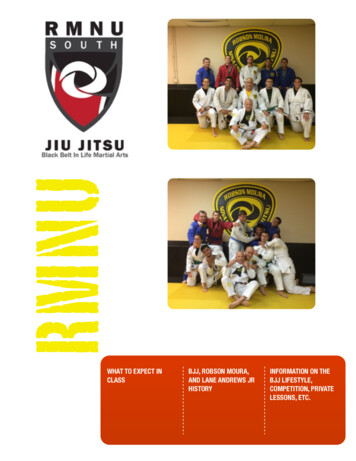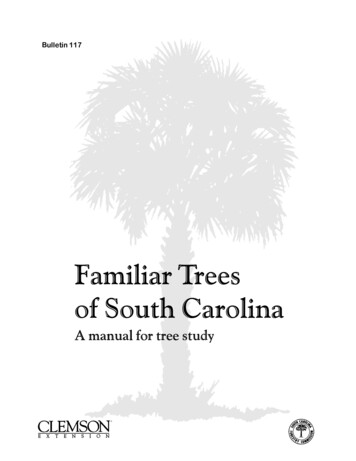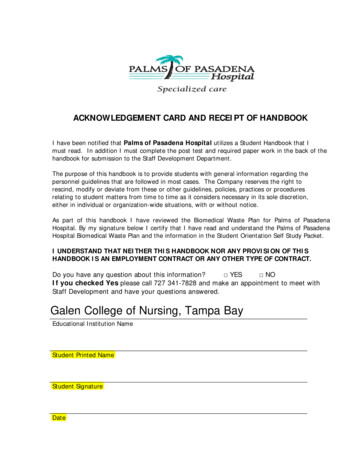
Transcription
RMNUWHAT TO EXPECT INCLASSBJJ, ROBSON MOURA,AND LANE ANDREWS JRHISTORY[1]INFORMATION ON THEBJJ LIFESTYLE,COMPETITION, PRIVATELESSONS, ETC.
Table of Contents Welcome BJJ History Robson Moura History Lane Andrews History John Ortolani Bio Private and Semi-Private lessons Positions Submissions and Tapping out Belt Ranking System RMNU Kids Competition Point System[2]
WELCOMEWelcome to RMNU South Tampa sequence of movements to breakJiu-Jitsu!down the opponents defenses untilwe catch them in a submissionWe are part of Robson Mouraforcing them to tap out (sayNations United, better know asuncle)!!! Here is the BJJ formula toRMNU! There are over 50success: Maximum Effectivenessassociations throughout the World Minimum Effort. It truly iswith the RMNU Headquarters inHuman Chess!!!Tampa, FL. We encourage arelaxed and friendly trainingenvironment with the goals ofimproving your self defense skills,and physical conditioning. The BJJlifestyle is built on a foundation ofhealthy living, which includes bothnutrition and physical activity.Robson winning his 8th WorldChampionship at the IBJJFMaster/Seniors WorldChampionshipIn addition to promoting a healthylifestyle, BJJ does what othermartial arts claim to do: provide apath for a smaller, weaker person todefeat a larger, stronger opponentthrough leverage, timing, anddeception! We use an elaborateLong Beach State Pyramid.Home to the IBJJF WorldChampionshipRobsonCoaching at theIBJJF WorldChampionship[3]
DON’T GET DISCOURAGED IF YOU ARE NOT A NATURAL. BJJ IS A MARATHON NOT ASPRINT!!!What to expectexperience. They struggled at first, but with consistenttraining they eventually became good! Some are nowWorld Class Black Belts!!! My point is this: “DON’TGET DISCOURAGED IF YOU ARE NOT ANATURAL!” We will welcome you to the family andturn you into a quality Jiu-jitsu player!Classes usually begin by lining up with theinstructor(s) at the front of the room facing thestudents. The students will be in single lines in rankorder from right to left. Once we bow into class wewill begin a 10 to 15 minute warm-up including coreexercises to get your body prepared for training. Afterthe warm up, you will learn and/or drill one to threetechniques (sweeps, escapes, or submissions). Thetraining session will end with sparring sessions wherecompetitors start the match on their knees. We startfrom the knees primarily for the safety ofeveryone on the mat. When a lot of studentsWe believeare training at the same time takedowns canthat Jiu-Jitsuresult in injuries. We do have classesis fordedicated to takedowns, as they are aneverybodyimportant part of BJJ; they are just not a partof most sparring sessions.BJJ is a journey! It won’t come easy at first but withpatience and consistency you will learn. How quicklyyou progress will depend on your physical attributes,prior martial arts/wrestling training, and how often youtrain (you must train at least two days a week toimprove but the more you train the quicker you willsee the results). We believe that Jiu-jitsu is forEVERYBODY!!! Many students start BJJ trainingwith little physical attributes and no ground fighting[4]LEARNING TO FIGHTON THE GROUND ISESSENTIAL!NINETY EIGHTPERCENT OF ALLSTREET FIGHTS ENDUP ON THE GROUND.BJJ IS ESSENTIAL TOSTREET SURVIVAL!!!
STUDENT RESPONSIBILITIES1. Have fun! Leave yourego at the door.2. Be on time and on themat ready to participatein class. If you arrivelate, please wait forpermission from theinstructor to cross themat or join the class.bacterial wipes.5. Clean yourequipmentregularly(headgear, kneepads, etc.)6. No shoes onthe mat.Have fun!Leave your egoat the door.3. Please wear RMNU gear 7. Be respectful of others.for both Gi and No-Gi8. Tap out when you aretraining.caught in a submission4. Proper hygiene is athat you can no longermust. Keep nails cutcounter. It’s best to tapshort and clean. Washearly to avoid injuries.your Gi after each class.9. Take all belongingsWash hands or usesanitizer before and afterhome with you afterclass. To reduce the riskclass.of bacterial infections10.Do not disrupt youryou should shower assoon as possible afterteam members training.class. If you can’tPlease be quiet whileshower use antithe instructor is[5]teaching.11.Keep an open mind andenjoy the experience.12. Get in the best shapeof your life!!!
The History of Jiu-JitsuGastao became a Jiu-JitsuSome historians of Jiu-Jitsu say that enthusiast and brought his oldestthe origins of "the gentle art" can be son, Carlos, to learn from theJapanese master.traced back to India, whereBuddhist Monks practiced it.Concerned with self-defense, thesemonks created techniques basedupon principles of balance andleverage, and a system ofmanipulating the body in a mannerwhere one could avoid relying uponstrength or weapons. With theexpansion of Buddhism, Jiu-JitsuCarlos Graciespread from Southeast Asia toChina, finally arriving in JapanFor a naturally frail fifteen-year oldwhere it developed and gainedCarlos Gracie, Jiu-Jitsu became afurther popularity.method not simply for fighting, butIn the last days of the 19th century, for personal improvement. Atnineteen, he moved to Rio desome Jiu-Jitsu masters emigratedJaneiro with his family and beganfrom Japan to other continents,teaching the martial arts as well as teaching and fighting. In his travels,Carlos would teach classes, andtaking part in fights andalso proved the efficiency of the artcompetitions.by beating opponents who werephysically stronger. In 1925, heThe Evolution of Jiu-Jitsu intoreturned to Rio and opened the firstBrazilian Jiu-Jitsuschool, known as the "AcademiaGracie de Jiu-Jitsu."Esai Maeda Koma, also known as"Conde Koma," was one suchmaster. After traveling with atroupe, which fought in variouscountries in Europe and theAmericas, Koma arrived in Brazilin 1915, and settled in Belem doPara the next year, where he met aman named Gastao Gracie.Esai Maeida Komabecame a pioneer in creating aspecial diet for athletes, "the Graciediet," which transformed Jiu-Jitsuinto a term synonymous withhealth.Having created an efficient selfdefense system, Carlos Gracie sawin the art a way to become a manwho was more tolerant, respectful,and self-confident. With a goal ofproving Jiu-Jitsu’s superiority overother martial arts, Carloschallenged the greatest fighters ofhis time. He also managed thefighting careers of his brothers.Because they were fighting anddefeating opponents fifty or sixtypounds heavier, the Gracies quicklygained recognition and prestige.Attracted to the new market, whichwas opened around Jiu-Jitsu, manyJapanese practitioners came to Rio,but none were able to establishschools as successful as theGracies. This was due to the factthat the Japanese stylists were morefocused on takedowns and throws,and the Jiu-Jitsu the Graciespracticed had more sophisticatedground fighting and submissiontechniques. Carlos and his brotherschanged and adapted the techniquesin such a way that it completelyaltered the complexion of theinternational Jiu-Jitsu principles.These techniques were soSince then, Carlos started to sharedistinctive to Carlos and hishis knowledge with his brothers,brothers that the sport becameadapting and refining theattached to a national identity, andtechniques to the naturally weakeris now commonly known ascharacteristics of his family. Carlos "Brazilian Jiu-Jitsu," practiced byalso taught them his philosophies of martial artists all over the world,life and his concepts of naturalincluding Japan.nutrition. Eventually, Carlos[6]
History of Jiu-jitsu ContinuedIn order to prove the effectivenessof his new system, The Gracie’sopenly challenged all the reputablemartial artists in Brazil andsuccessfully defeated all whoaccepted.Sport BJJ tournaments continue togrow in popularity worldwide andhave given rise to no-gi submissiongrappling tournaments, such as theADCC Submission WrestlingWorld Championship.main self-defense system for handto-hand combat.BJJ is not solely a martial art: it isalso a sport; a method forpromoting physical fitness, properThe Governing Body of Brazilian Jiu- nutrition, building character inyoung people, and, ultimately, aJitsu (IBJJF)lifestyle.Helio GracieWith the creation of an officialHelio Gracie, the youngest son ofgoverning body to oversee theGastão Gracie would eventuallyadministration of the sport,help his brother Carlos refine theincluding competition rules and thetechniques of Brazilian Jiu-jitsu.grading system, the era of sport JiuJitsu competitions was started.Jiu-Jitsu came to internationalToday, Jiu-Jitsu is a highlyprominence in the martial artsorganized sport, with ancommunity in the early 1990s,International Federation as well as awhen Brazilian jiu-jitsu expertBrazilian National Confederation,Royce Gracie (Helio’s Son) wonboth founded by Master Carlosthe first, second and fourth Ultimate Gracie Jr. Through his work withFighting Championships, which at the Confederation of Brazilian Jiuthe time were single eliminationJitsu, Carlos Gracie Jr. contributedmartial arts tournaments. Royceto the growth of the sport byfought against often much-largerholding some of the first organizedopponents who were practicingcompetitions. Currently, the IBJJFother styles, including boxing,and CBJJ holds competitions inshoot-fighting, muay thai, karate,Brazil, the United States, Europe,wrestling, judo and tae kwon do. It and Asia, realizing Carlos' originalhas since become a staple art fordream of spreading Jiu-Jitsu aroundmany MMA fighters and is largely the world.credited for bringing widespreadattention to the importance ofBrazilian Jiu-Jitsu Todayground fighting.BJJ has proven itself as the mosteffective form of self-defense in theworld. It is now the basis of mixedmartial arts tournaments and has alarge sport competition following.Jiu-Jitsu has something foreveryone from the competitiveathlete to the weekend warrior.Many law enforcement and themilitary agencies use BJJ as theirHelio Gracie[7]
HISTORY OF NOVA UNIAO JIU-JITSUIn the early 1990s, when competition jiu-jitsu was starting to become popular in Rio, a new team was founded,joining the two zones of the city. Carlson Gracie (Carlson is the eldest son of Carlos Gracie, the founder ofBrazilian Jiu-jitsu) pupil Andre Pedeneiras (a black belt in jiu-jitsu and judo) had a strong team in Botofogo, inthe South of Rio de Janeiro. To expand, he looked for new members for his team in the northern area of the city.At this time, the North Zone was considered technically inferior in jiu-jitsu and Andre aimed to help the area aspart of his quest.Meaning “New Union”, the Nova União Jiu-Jitsu Academy was founded in Rio de Janeiro in 1995 when theMello Tenis Clube Jiu-Jitsu, headed by Wendell Alexander, joined with Andre’s team. Wendell was a black beltfrom Sebastião Ricardo, who in turn was a student of the Master Oswaldo Fadda, one of the few people to trainin Brazil under Sensei Maeda of Japan. The was significant because Wendell Alexander’s lineage is the onlynon-Gracie lineage for Brazilian Jiu-jitsu. Essentially, Nova Uniao married the only two lineage’s in BJJ!!!Within a few short years the team had a production line of local (state), national (Brazilian) and worldchampions, which culminated in the team winning the Team Division at the 1997 World Championship. Withina few short years the team had a production line of local (state), national (Brazilian) and world champions,which culminated in the team winning the Team Division at the 1997 World Championship.In Brazil, Rodrigo “Feijao”, Wendell Alexander, Leonardo Santos, and Andre Marola have been responsible forre-structuring Nova Uniao to once again be in the Jiu-Jitsu spotlight, since over the years, the focus of the teamin Brazil has gravitated towards MMA producing UFC champions BJ Penn and Jose Aldo among others.In the US, Gustavo Dantas (Nova Uniao USA President), Robson Moura (Vice-President) and Bruno Bastos hasmade it their priority to organize Nova Uniao to compete at IBJJF tournaments, the World’s largest, and mostrespected, stage for Jiu-Jitsu events.In 2014, Robson Moura left Nova Uniao to create Robson Moura Nations United (RMNU) to provide support tohis 50 plus associated academies.[8]
THE HISTORY OF ROBSON“ROBINHO” MOURARobson “Robinho” Moura is a 4thdegree black belt in Brazilian JiuJitsu and a 8X World Champion. Heis from Teresopolis (a small town inthe mountains of Rio de Janeiro,Brazil), and currently resides inTampa, FL. where he establishedThe Robson Moura Academy.Robson has been competing in BJJcompetitions since the age of 13.With an excellent martialphilosophy, hard working style andlove of the game, he is among thegreatest of the world’s Jiu-Jitsuplayers.Robson holds his black belt inBrazilian Jiu-Jitsu under worldrenowned Nova Uniao, co-founderMaster Andre Pederneiras. Robsonattained the rank of 1st degree blackbelt at the age of 18 under Andre!The sport history of this ‘Carioca’begins in 1988 at the age of 10when he started training Jiu Jitsu inhis hometown of Teresopolis (asmall town in the mountains of Riode Janeiro, Brazil). His firstBrazilian Jiu-Jitsu teacher wasJucao. Robinho was supported andencouraged by his family,especially his father.Robinho quickly grew his skills,becoming a champion of manycompetitions, and collecting anumber of regional titles. When hisinstructor Jucao moved to Rio,Robson started training underMaster Andre Pederneiras andWendel from the eliteteam Nova Uniao.He continued to grow hisskills and abilities,achieving national andinternational titles,becoming very wellrespected and esteemed.He is considered to have avery proficient andcompetitive way of fighting. By 18Robson had achieved his greatestdream by becoming a Black Beltand today his is one of the mostvalued players in Brazilian JiuJitsu.JIU-JITSU HAS NO END (SEE LINKBELOW)In this short documentary, RobsonMoura teaches a seminar in the UKand talks about his approach to BJJand what he has learned not only inthe sport, but in life over the yearsthrough hi
Belt Ranking System RMNU Kids . IBJJF World Championship Robson winning his 8th World Championship at the IBJJF Master/Seniors World Championship [4] DON’T GET DISCOURAGED IF YOU ARE NOT A NATURAL. BJJ IS A MARATHON NOT A SPRINT!!! What to expect Classes usually begin by lining up with the instructor(s) at the front of the room facing the students. The students will











